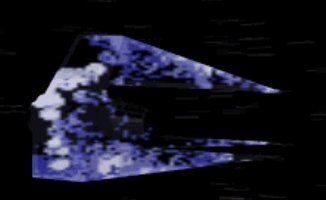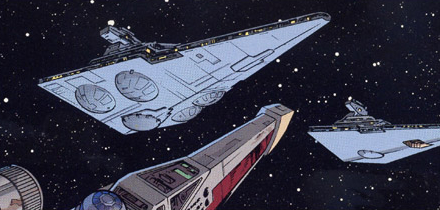|
|
 |
The hyperdrive allows starships to accelerate faster
than light and propel it into the dimension called hyperspace. A
vehicle can cover huge expanses of space in an instant. Hyperdrives are
generally equipped with navigational
computers to determine safe routes around stars, planets,
asteroids, and stellar debris. Hyperdrives are categorized by class,
with lower classes meaning faster speeds.
- Class 3 - civilian craft
- Class 2/Class 1 - most military vehicles
- Class 0.75/Class 0.5 - rare or result of exceptional
modifications
|
|
 |
An ion engine is a propulsion person found on virtually
every starship and is responsible for nonhyperspace
travel. It is powered by local power cells, liquid reactants, or
onboard generators. The device uses an internal fusion reaction to
produce stream of charged particles, which is channeled through the
engine's exhaust ports to provide forward movement.
|
|
 |
A repulsorlift engine is commonly used by land,
atmosphere, and spacecraft. The system uses a fusion generator to
produce a antigravity field, which enables the vehicle to hover
anywhere between a few centimeters and several hundred meters above a
planet's surface. It is the primary engine system found on airspeeders.
Starships and fighters use repulsorlifts to travel or land inside
atmosphere. Repulsorlifts can be integrated into flying droids,
hovering cargo containers, and floating cities.
|
|
 |
Sublight drives maneuver vehicles through realspace,
and usually employ one of several engine technologies, including ion engines. Sublight drives are
always engaged when leaving atmosphere and during space battles. They
also protect pilots and passengers from varying gravitic effects during
sudden changes in acceleration.
|
|
 |
Blaster cannons are limited range heavy artillery
weapons that fire bursts of energy. They are quite effective during
atmospheric combat against ground troops or military structures. They
can be mounted on many repulsorlift
craft and other ground vehciles, but blaster cannons are not as
powerful as laser cannons.
|
|
 |
Concussion missiles travel at sublight
speeds and cause damaging shock waves upon impact. They are especially
effective against large, stationary targets and capital ships. The
missile was originally developed by pirates and mercenaries and later
adapted by the Empire
to use aboard bombers. Rebels
used concussion missiles to destroy the Death
Star II.
|
|
 |
Ion cannons are capable of disabling starships without
causing damage. The Armek SW-4 onboard the Y-Wing is one of the most
common. They fire powerful bolts of ionized energy designed to overload
a target's systems or fuse mechanical components. During war, ion
cannons were used to capture cargo, prisoners, and prized vehicles
while keeping them intact.
|
|
 |
The laser cannon is the dominant weapon in the galaxy
and is found on all military and many civilian vehicles. They are
essentially large and powerful blasters that fire bolts of concentrated
energy to damage their targets. They have incredible range and rapid
recharge rate. Laser cannons are light, easy to install and modify, and
relatively inexpensive. They are complemented by computerized targeting systems that provide
increased accuracy and advanced cooling systems that prevent
overheating. They draw power directly from a vehicle's generator or
alternate power sources. They are effective against most structures,
small ground-and aircraft, and starfighters. However, they cannot
penetrate thick hulls and shields of capital ships.
|
|
 |
The proton torpedo is a common concussion weapon found
aboard modern starfighters and capital ships. They are high-speed
projectiles fired from special tubes. When a torpedo impacts its
target, the high-yield warhead detonates and releases a devastating
wave of protons. They can bypass standard deflector
shields, but can only be stopped by complete particle
shielding. A well-placed torpedo can seriously cripple a capital ship.
Torpedoes are aided by advanced guidance computers and are almost
impossible to dodge. Variations of the proton torpedo include the
proton bomb and proton hydrotorpedo.
|
|
 |
Capital ships, military installations, and space
stations support much larger and more destructive laser
cannons called turbolasers. Turbolasers can tear through
armored starships and destroy entire starfighter squadrons. The range
of a turbolaser is between double and triple that of a laser cannon.
They recharge slowly, require dedicated turbines, multiple capacitor
banks, and cryogenic cooling systems. Energy flow must be monitored to
avoid power surges. Turbolasers can be dodged easily by skilled pilots.
Placement is critical as incomplete defensive coverage will allow
starfighters to slip through openings to attack the starship or
installation.
|
|
 |
Astromech droids are general utility droids designed to
aid in the maintenance and use of vehicles. They are grouped in series
from R1 to R7. Most are able to calculate coordinates for hyperspace
jumps, aid in navigation, and make repairs. Many starfighters are
manufactured to carry astromechs in special sockets to allow the
astromech to interface more efficiently. R2 units may be the most
versatile as they can:
- evaluate flight performance
- make adjustments to increase vehicle's efficiency
- identify, isolate, and repair malfunctions
- store up to 10 sets of hyperspace coordinates
|
|
 |
Cloaking devices are extremely rare and difficult to
acquire. They render starships invisible to sensors
by disrupting electromagnetic waves that can be detected by scanners.
Cloaks are traditionally powered by stygium crystals. The Emperor researched new
cloaking technologies, seeking alternatives to stygium-powered devices.
Most experiments were unsuccessful, but at least one working prototype
was produced. All modern, nonstygium cloaking devices were bulky and
required independent power sources, which limited use to larger
starships.
|
|
 |
Deflector shields are vital to survival aboard any
starship. They surround craft in two protective force fields: ray
shielding and particle shielding. Ray shielding(energy shielding) is
designed to absorb radiation and raw energy, including laser
cannon fire. Particle shielding repels solid objects such as
concussion weapons and space debris. Ray shielding is only engaged
during combat, but particle shielding is generally always activated to
avoid accidental collisions. The power source determines strength of
shield, radius, and amount of damage absorbed. Civilian-grade shields
usually burn out after absorbing a significant amount of damage, but
military-grade shields recharge over time. Ground vehicles can be
equipped with weak shield generators, but only starfighters and
starships carry power sources necessary to support high-end shields.
|
|
 |
Space travel is dangerous. When a starship is disabled,
passengers and crew may board escape pods: space capsules equipped with
fundamental life support and survival supplies. They range from small,
one person lifeboats to expensive, environmentally sealed salon pods
found aboard Republic cruisers.
Once launched, the pod will scan surrounding space in search of
suitable planet. Rudimentary sublight
drive points the pod toward this safe planet. A repulsorlift engine equipped
with maneuvering jets aids in landing. Passengers are strapped into
padded g-couches for protection.
|
|
The navicomputer is the key component of any
navigational system and works in conjunction with the hyperdrive and sensor systems to calculate
lightspeed jumps, as well as realspace trajectories and travel routes.
They are programmed with hundreds of astronavigation charts and are
designed to interact with astromechs
and other droids. Ground vehicles and planetary aircraft use nav
computers to determine safe routes over land or in atmosphere.
|
|
 |
While traveling throughout the galaxy, starships are
constantly gathering information from the space around them. Starship
pilots need to identify and locate other starships, stellar hazards,
planets and moons, and galactic anomalies. Planetary vehicles need to
collect similiar data, including updates relating to the terrain and
weather. The sensor array scans the surrounding area and sends the
information to onboard computers, which then displays updates for the
pilot and crew. Passive-mode sensors only evalutae the area directly
around a vessel. More powerful scan-mode sensors can gather information
in a much wider range. Search-mode sensors are programmed to search for
information in specific directions. Focus-mode sensors can closely
study a small area of space or environment. The most common scanners
are:
- electro-photo receptors(EPRs)
- full-spectrum transceivers(FSTs)
- dedicated energy recptors(DERs)
- crystal gravfield traps(CGTs)
- hyperwave signal interceptors(HSIs)
- life-form indicators(LFIs)
|
|
 |
Nearly all weapon systems are complemented by targeting
computers designed to acquire and track fast-moving objects, such as an
enemy starfighter. They communicate with a navicomputer
and sensor array to identify
possible targets within range. The targeting computer can also
calculate trajectories to determine attack and intercept courses.
Aboard larger starships, independent combat computers control turret
servos to make constant adjustments, improving firing accuracy
throughout a battle. However, targeting computers can never replace a
competent pilot or skilled gunner and can't predict the unexpected
movements of a creative enemy or react intuitively to new situations.
|
|
 |
Tractor beams are modified force fields capable of
immobilizing and moving objects in space. They are most often used to
guide incoming starships into landing bays. Other craft use tractor
beams to move salvage or cargo, retrieve stranded vehicles or pilots,
and reposition space stations and orbital structures. Imperial Star Destroyers
use tractor beams to capture enemy vessels, which can then be boarded
or destroyed by turbolasers.
They require a great deal of onboard space, maintenance, and power. The
largest tractor beams demand crews of ten technicians and operators,
and are dependent upon a bulky reactor. Tractor beams aboard the Death Star were coupled
to the main reactor, which provided a constant flow of energy.
|
|
 |
The Empire
developed artificial gravity well generators, which sent out powerful
waves that disrupted mass lines in space. This simulated the presnese
of a large stellar body(asteroid/planet). The presence of this
simulated mass prevented ships from engaging their hyperdrives and dropped ships
already in hyperspace back to realspace. G-7x generators are the main
weapon of Imperial Interdictor-class
heavy cruisers. Powering up the generators takes 30 seconds and it
takes the capacitors 40 seconds to shunt power and completely recycle.
This great energy output also affects movement and handling of the
interdictor.
|
|
 |
The Death Star's
main weapon unleashed a great amount of energy capable of destroying
entire planets. The energy started in the station's core and then was
channeled into an array of eight laser
cannons. The beams converged into one large blast that was
directed from the eye-shaped area of the Death Star. Teams of highly
skilled Imperial
gunners manned control stations, managing the mammoth weapon. With this
weapon, the Death Star destroyed the planet of Alderaan, but it was
destroyed at the Battle of Yavin.
The Empire built a second
Death Star and the new cannon could target capital ships and
supported frequent firing. Like its predecessor, it was destroyed.
|


















